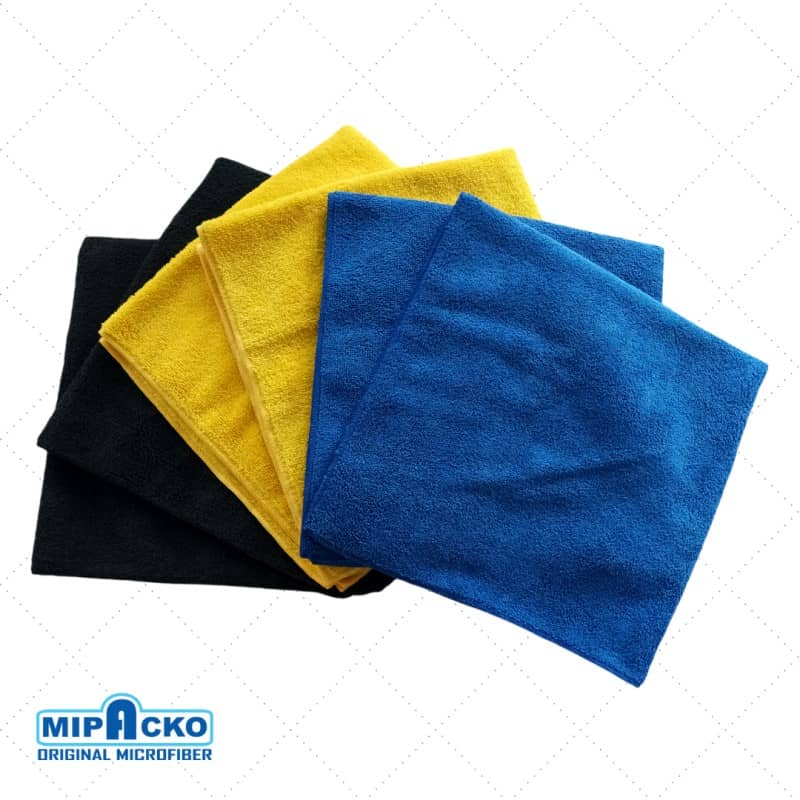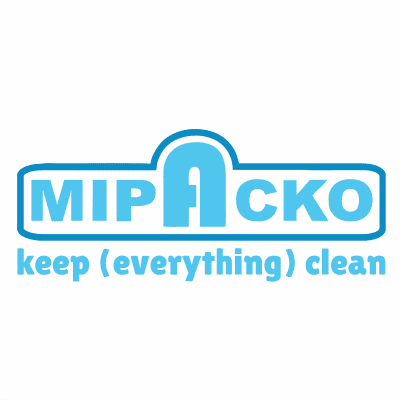A clean and well-maintained fridge is not only essential for food safety but also for the efficient operation of your appliance. Regular cleaning of your fridge helps prevent the growth of harmful bacteria, mold, and odors, ensuring that your stored food remains fresh and uncontaminated. In addition to food safety, a clean fridge contributes to a more hygienic kitchen environment, making it an essential part of home maintenance.
Introducing Microfiber Cloth as a Cleaning Tool
One of the most versatile and effective cleaning tools at your disposal is the microfiber cloth. Microfiber cloths are made from tiny synthetic fibers that are incredibly efficient at trapping dirt, dust, and grime without the need for harsh chemicals.
In this article, we’ll not only discuss the importance of regular fridge cleaning but also introduce microfiber cloth as a key tool in achieving a thorough and environmentally friendly cleaning process. Its ability to clean without leaving streaks and its durability make it a perfect choice for keeping your fridge spotless. In the following sections, we’ll delve into three effective tips for cleaning your fridge , with a special focus on how microfiber cloths can enhance the process.
Read More : Simple Ways to Clean a Kitchen Sink and Drain
Preparing Before You Start
a. Turning Off and Emptying the Fridge
Before you begin the cleaning process, it’s crucial to ensure your safety and the preservation of your food. Start by turning off the fridge . Most fridge have a power button or temperature control that can be adjusted to the “off” position. Alternatively, you can unplug the appliance from the electrical outlet.
Once the fridge is turned off, it’s time to empty its contents. Remove all food items, condiments, and shelves from inside. If possible, transfer the items to a cooler or another fridge to keep them at a safe temperature. Ensure that the food is securely covered to prevent any spillage or contamination during the cleaning process.
b. Gathering Necessary Tools and Supplies
To clean your fridge effectively, you’ll need a few tools and supplies. Here’s a checklist of items to gather:
- Microfiber cloths: Microfiber cloths are ideal for cleaning the interior and exterior of your fridge . They are highly absorbent and trap dirt and bacteria effectively without the need for harsh chemicals.
- Warm, soapy water: Prepare a solution of warm water and a mild dish soap. This will be used for cleaning the interior surfaces of the fridge.
- Baking soda: Baking soda is excellent for removing odors from the fridge . You’ll need this to keep your fridge smelling fresh.
- Scrubbing brush or toothbrush: Use a soft-bristle brush to scrub away tough stains or residue in hard-to-reach areas.
- Vinegar: White vinegar can be used for disinfecting and eliminating any lingering odors.
- Containers for food storage: Have containers ready to hold the food you remove from the fridge.
- Towels or paper towels: These will come in handy for drying the cleaned surfaces.
- A bucket or basin: Use this to mix your soapy water and carry cleaning supplies around.
- Rubber gloves: It’s a good idea to wear gloves to protect your hands from cleaning agents and to maintain hygiene.
Having these tools and supplies at your disposal will make the cleaning process more efficient and ensure you have everything you need to get your fridge sparkling clean.

Tip #1: Cleaning the Inside of the Fridge
a. Emptying the Fridge
Before you dive into cleaning the interior of your fridge , it’s essential to start with a clean slate. Empty the fridge completely. Remove all food items, containers, and shelves. Take this opportunity to check for any expired or spoiled food and dispose of it. Place the food you intend to keep in a cooler or another fridge to keep it at a safe temperature.
b. Removing Stains and Food Residue
With the fridge empty, it’s time to tackle stains and food residue. Start by examining the interior surfaces, including the walls, shelves, and drawers. Any visible stains, spills, or dried food residue should be addressed.
- For fresh spills: Wipe up fresh spills with a microfiber cloth or a paper towel.
- For stubborn stains: To remove stubborn stains, create a paste using baking soda and water. Apply the paste to the stained area, let it sit for a few minutes, and then gently scrub with a soft brush or a toothbrush. Rinse the area with warm soapy water and wipe it dry.
c. Cleaning Shelves and Interior Components
Next, focus on the removable components of the fridge , such as shelves and drawers. Remove these components one at a time and wash them with warm soapy water. Be sure to rinse thoroughly to remove any soap residue, and then dry them with a clean cloth.
Pay close attention to the rubber gaskets around the door; these can collect dirt and grime. Clean the gaskets with a microfiber cloth and warm, soapy water, making sure to remove any debris that may be affecting the seal.
d. Using Microfiber Cloth for Cleaning the Interior Surfaces
The interior surfaces of your fridge can be effectively cleaned with a microfiber cloth. Microfiber cloths are excellent at trapping dirt, bacteria, and moisture without leaving streaks or lint behind.
- Wet the microfiber cloth: Dampen a microfiber cloth with warm, soapy water or a vinegar-water solution for disinfection.
- Wipe down surfaces: Starting from the top and working your way down, wipe down all interior surfaces, including the walls and the back of the fridge. Pay special attention to corners and crevices where dirt and spills tend to accumulate.
- Rinse and repeat: Rinse the cloth as needed and continue wiping until all surfaces are clean and free of residue.
- Dry the interior: Finally, use a dry microfiber cloth or paper towel to ensure that all surfaces are completely dry, as moisture can lead to the growth of mold and mildew.
Following these steps will leave the interior of your fridge clean and ready for your fresh food items, all while utilizing the effectiveness of a microfiber cloth for the cleaning process.
Tip #2: Cleaning the Exterior of the Fridge
a. Cleaning the Door, Handles, and Control Panel
The exterior of your fridge can accumulate dirt, fingerprints, and smudges over time. To maintain a clean and attractive appearance, start by cleaning the key areas.
- Door: Wipe down the entire front door of the fridge using a microfiber cloth dampened with warm, soapy water. Pay attention to any spills, stains, or sticky residue, and ensure that the gasket around the door is clean and free of debris.
- Handles: Clean the handles with the same microfiber cloth and soapy water solution. Be thorough, as handles can collect a surprising amount of grime.
- Control Panel: If your fridge has a control panel, use a microfiber cloth lightly dampened with water to clean it. Avoid using excessive water around the control panel to prevent damage.
b. Removing Fingerprints and Stains on Stainless Steel
Stainless steel fridges are popular for their sleek and modern appearance, but they can show fingerprints and stains easily. Here’s how to restore their shine:
- Fingerprint removal: Apply a small amount of a stainless steel cleaner or a mixture of equal parts vinegar and water to a microfiber cloth. Gently wipe the stainless steel surface in the direction of the grain to remove fingerprints and smudges.
- Stain removal: For tougher stains, create a paste using baking soda and water. Apply the paste to the stain, let it sit for a few minutes, and then gently scrub with a soft cloth. Rinse the area with clean water and dry it thoroughly.
c. Maintaining the Exterior Appearance with Microfiber Cloth
Microfiber cloths are your best friend when it comes to maintaining the exterior appearance of your fridge . They are perfect for achieving a streak-free shine and can be used for regular maintenance.
- Buffing for shine: After cleaning, use a dry microfiber cloth to buff the exterior surfaces of the fridge. This will remove any remaining moisture and leave the exterior looking shiny and clean.
- Regular touch-ups: To prevent the buildup of grime, make it a habit to do quick touch-ups with a microfiber cloth as needed. This will help maintain the fridge ‘s cleanliness between more thorough cleanings.
Following these steps will not only keep the exterior of your fridge looking spotless but also ensure that it remains in top condition for years to come. Microfiber cloths are excellent for maintaining that streak-free shine and eliminating unwanted smudges.
Tip #3: Preventing Unpleasant Odors
a. Eliminating Existing Odors
Unpleasant odors in your fridge can be a common issue, but they can be eliminated with a few simple steps:
- Empty the fridge: As discussed earlier, start by emptying your fridge to identify the source of the odor. Check for any expired or spoiled food items and remove them.
- Clean thoroughly: Clean the interior of the fridge using warm, soapy water. Be sure to scrub all surfaces, including shelves, drawers, and walls, to remove any lingering odors.
- Use baking soda: Place an open box of baking soda in the fridge to absorb odors. Baking soda is a natural deodorizer that can effectively neutralize unwanted smells. Replace the box every few months for best results.
- Charcoal or coffee grounds: In addition to baking soda, activated charcoal or coffee grounds can also help absorb odors. Place them in open containers or fabric sachets and position them strategically in the fridge.
- Citrus or vanilla: Fresh citrus peels or a few drops of vanilla extract on a cotton ball can impart a pleasant scent to your fridge while masking any remaining odors.
b. Preventing Odors with Natural Remedies
Prevention is key when it comes to fridge odors. Here are some natural remedies to help keep your fridge smelling fresh:
- Proper food storage: Store food in airtight containers to prevent odors from spreading. This also helps maintain the quality of your food.
- Regular cleaning: Make a habit of regular fridge cleaning to prevent the buildup of spills and residues that can lead to odors.
- Keep it organized: Organize your fridge so that older items are used before newer ones, reducing the chance of forgotten, expired items.
- Air circulation: Keep the air in your fridge circulating by not overloading it with food items. Proper airflow can help reduce moisture and odors.
c. The Role of Microfiber Cloth in Odor Prevention
- Absorbing moisture: Microfiber cloths are excellent at absorbing moisture, which can help reduce the conditions that lead to mold and mildew growth, common culprits of unpleasant odors.
- Cleaning effectively: Regular cleaning with microfiber cloths can prevent the buildup of spills and residues that can contribute to odors in your fridge.
- Eco-friendly odor removal: Instead of relying on chemical-based air fresheners, microfiber cloths can help eliminate odors without the need for additional products.
By following these steps and utilizing natural remedies, such as baking soda and microfiber cloths, you can effectively prevent and eliminate unpleasant odors in your fridge, ensuring a fresher and more inviting environment for your stored food items.
Caring for Microfiber Cloth
a. Washing Microfiber Cloth
Microfiber cloths are durable and long-lasting, but they require proper care to maintain their effectiveness and cleanliness. Here’s how to wash them:
- Separate from other laundry: When it’s time to wash your microfiber cloths, separate them from your regular laundry. This helps prevent lint and debris from other fabrics from transferring to the microfiber, which can reduce its effectiveness.
- Use cold or warm water: Wash microfiber cloths in cold or warm water to avoid damaging the delicate fibers. Avoid using hot water, as it can break down the fibers and reduce their efficiency.
- Use a gentle detergent: Opt for a gentle detergent, free from bleach or fabric softeners, as these can harm the microfiber. A mild liquid detergent is typically a safe choice.
- Avoid using fabric softeners: Fabric softeners can leave a residue on the microfiber that reduces its absorbency and cleaning power. It’s best to skip the fabric softener altogether.
- Choose a gentle wash cycle: Use a gentle or delicate wash cycle to minimize wear and tear on the cloths.
- Avoid using bleach: Never use bleach when washing microfiber cloths, as it can damage the fibers.
- Dry on low heat or air dry: When it’s time to dry your microfiber cloths, use low heat or air-dry settings in your dryer. High heat can cause the fibers to melt or become damaged. Air drying is the safest option.
b. Maintaining Microfiber Cloth Quality for Effective Cleaning
To ensure your microfiber cloths remain effective and last a long time, follow these maintenance tips:
- Inspect for damage: Regularly inspect your microfiber cloths for any signs of damage, such as fraying or tears. Damaged cloths may not perform as well and could potentially scratch surfaces.
- Replace as needed: If a microfiber cloth is significantly worn or damaged, it’s best to replace it. Using worn-out cloths can result in reduced cleaning efficiency.
- Store properly: Store your microfiber cloths in a clean, dry place, away from direct sunlight or excessive heat. This helps maintain their quality over time.
- Use the right cloth for the right job: Different microfiber cloths may have specific purposes, such as cleaning glass, dusting, or general cleaning. Use the appropriate cloth for each task to maximize effectiveness.
- Regularly wash and maintain: Make it a habit to wash and maintain your microfiber cloths after each use. This ensures they remain clean and ready for the next cleaning task.
By following these care and maintenance guidelines, your microfiber cloths will stay in excellent condition, providing you with efficient and effective cleaning tools for your fridge and other household tasks.
Read More : How to Clean an Electric Stove: Tips and Tricks for Keeping it Sparkling Clean
Conclusion
a. The Significance of Maintaining Fridge Cleanliness
Maintaining cleanliness in your fridge is of paramount importance, not just for the sake of appearances but also for your health and food safety. A clean fridge prevents the growth of harmful bacteria, mold, and odors that can contaminate your food. It ensures that the food you store remains fresh, free from cross-contamination, and safe to consume. Additionally, a clean fridge promotes a hygienic kitchen environment, reducing the risk of foodborne illnesses and contributing to an overall healthier home.
b. Benefits of Using Microfiber Cloth in the Cleaning Process
Incorporating microfiber cloths into your cleaning routine offers a wide range of benefits. Microfiber cloths are highly efficient at trapping dirt, bacteria, and moisture without the need for harsh chemicals, making them an eco-friendly and effective cleaning choice. The benefits of using microfiber cloths in the fridge cleaning process include:
- Streak-free shine: Microfiber cloths leave surfaces clean and streak-free, enhancing the visual appeal of your fridge.
- Versatility: They can be used for various cleaning tasks in the kitchen and throughout the home.
- Environmental friendliness: Microfiber cloths reduce the need for disposable cleaning products and are reusable, making them a sustainable choice.
- Time and effort savings: Microfiber cloths often require less effort to clean and remove dirt and stains effectively.
In conclusion, regular fridge cleaning is a fundamental aspect of maintaining a healthy and well-functioning kitchen. When you combine the significance of maintaining cleanliness with the benefits of using microfiber cloths, you not only ensure that your fridge stays in top condition but also contribute to a cleaner and safer living environment for you and your family. So, make it a routine to clean your fridge , and don’t forget to enlist the help of your trusty microfiber cloths to achieve the best results. Your kitchen will thank you for it.






